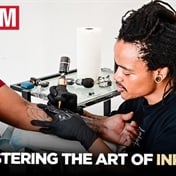
It’s hard to image that behind the faces you see daily, that beam with bright smiles, a deep problem might be within the person. Problems so severe that one resorts to finding an outlet using scissors, knives and blades to slip wrists. In a powerful Twitter thread, Tenhlanhla Shiba recently wrote about her journey to recovery from her self-harming past, which unearthed even more stories of self-harm survivors who now wear their scars as a symbol of strength.
“I started doing it because I had seen it on TV and at that time I was not aware of the ways to properly deal with mental-health issues,” Tenhlanhla tells us. “It was a helpful form of relief because it got me to focus more on physical pain rather than the emotional pain even though it was short relief.”
She recently shared on social media how she had gone for four months without harming herself and how the scars are a daily reminder of the strength she has, and how they keep her looking forward to brighter days. What she didn’t expect was for her tweet to take a life of its own.
More people came onto the thread to share their stories of how they had dealt and still deal with self-harming. Along with the massive wave of positivity and support, Zandile Simelane was among the lot that shared their stories. In a moment that was supposed to be her end at the age of 16, she tells DRUM how her turning point came about.
“I was in a girls’ boarding school, Grade 9 at Inanda Seminary in Durban,” she recalls. “Isolated and feeling alone, the gap to restart my harmful self-relief was ignited.”
The cause of her self-harming stretched three years back at just 13 when she lost her mother. “I began my pain, this time I scribbled a note at the back of one of my books. I can't recall the words, but I am certain I was finally saying my goodbyes. My friend found it and took it to the school priest. I ended up at Addington Hospital in a psychiatric ward with a 16-year-old who couldn't wait to announce to her new bed neighbour [me] that Luther Vandross was her man. I knew then that I had so much to be grateful for because I wasn't a lunatic. I was just crying for help!”
Tenhlanhla addresses how far the black community still has to go in understanding mental illness. “People think it is a way of getting attention, that it is a disgraceful act, and often at times in an African context people who self-harm can be seen as somehow being demon-possessed. Because people do not understand why someone would harm themselves willingly,” she says.
Clinical psychologist Nicole Schuitmaker adds that self-harming is not something that only plagues troubled teens, as most would like to believe. “People from all walks of life deal with self-harming. Furthermore, people believe that self-harm only involves cutting. This is not true, it can range from cutting, scratching, biting, burning and poisoning,” she explains.
“Many people who self-harm appear outwardly ‘normal’ but are struggling to cope with internal and/or external distress,” the Johannesburg-based psychologist says. “People believe that those who self-harm are depressed or ‘crazy’. Again, this is a misconception. Self-harm is a maladaptive coping strategy.”
However, Tenhlanhla circles back to explain that her post was to celebrate strength and having risen from a dark place. She also says it is an ongoing journey: “I deal by looking at my scars and being proud of myself for making it through another day without harming myself. I look at my scars as a reminder that I can get through everything and that gives me more reason to carry on fighting.”
Both Tenhlanhla and Zandile explain that they sought professional help at one point with Zandile placing emphasis on the importance of talking. “Talk! It's going to be OK. Too many times, when the cloud is above us we tend to drown in it and forget the possibility of seeing the sun's rays again.”
It doesn’t even have to be with a professional, she says. “Speak to someone close to you, they may not have all the answers but they can listen and guide where possible.”
Family members can play a role in identifying relatives who self-harm to seek help for them, Schuitmaker says. “Family members can look out for suspicious physical injuries, particularly if the person is trying to hide these injuries, such as with baggy clothing. They can also look out for personality changes, withdrawal, isolation and anhedonia. It would be advisable for that person to seek help from a psychologist or counsellor. There are also numerous helplines available, such as LifeLine and Sadag,” she says.
Ultimately, there is light at the end of the tunnel, shares Zandile who is also an active member within the community of People Living with HIV (PLWHIV). Where she once had scars of hopeless, now sits a tattoo that resonates hope and positivity. “I tattooed my scars because I have lived the pain, embraced the change and wanted to beautify the memories that made me strong. Hence the flowers and butterflies,” she says. “I am one for moving on and accepting situations I cannot change.”


















